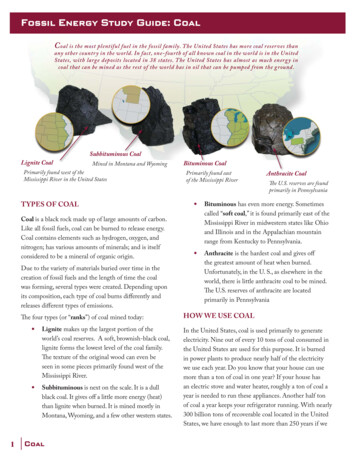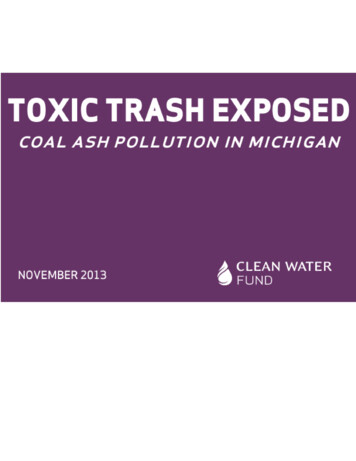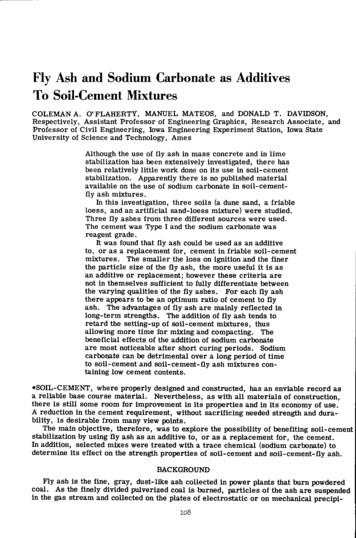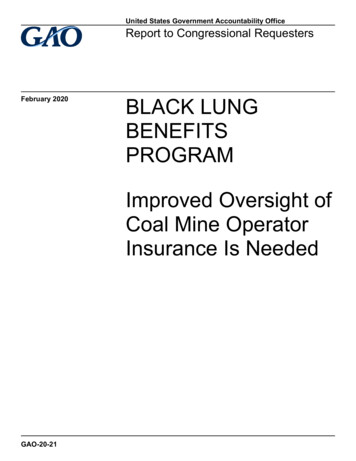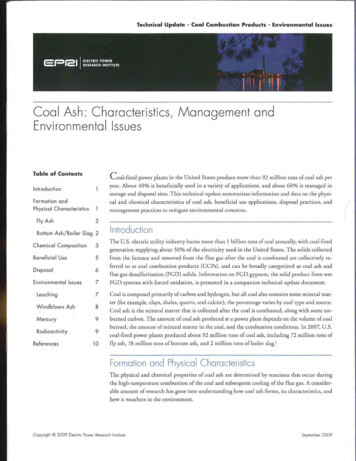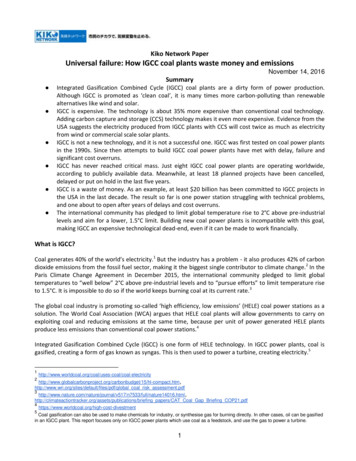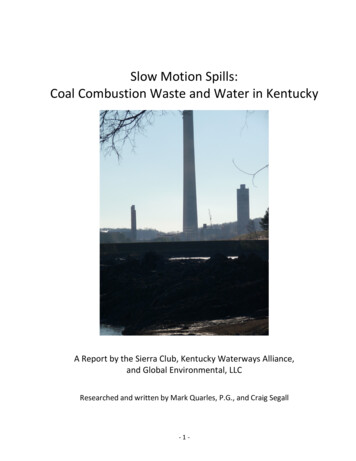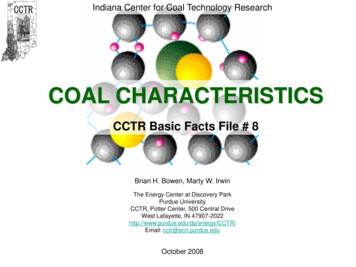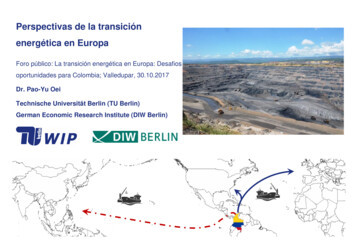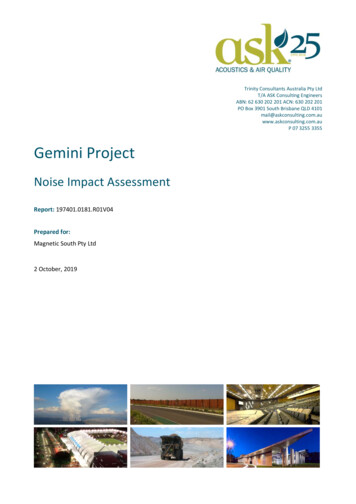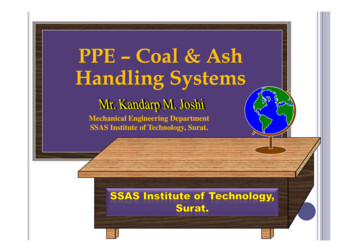
Transcription
PPE – Coal & AshHandling SystemsMechanical Engineering DepartmentSSAS Institute of Technology, Surat.
www.joshikandarp.webs.comSteps in Coal Handling
Unloading: The type of equipment to be used for unloadingthe coal received at power station depends on how coal isreceived at the power station. If coal is delivered by trucks, there is no need of unloadingdevice as the trucks may dump the coal to the outdoorstorage. In case the coal is brought by railway wagons, ships orboats, the unloading may be done by car shakes, rotary cardumpers, cranes, grab buckets and coal accelerators.Rotary car dumpers although costly, are quite efficient forunloading closed wagons.www.joshikandarp.webs.comCoal Delivery : The coal from supply points is delivered by ships or boats to PP if near to sea or river rail or trucks to the power stations which are situatedaway from sea or river. trucks is used if railway facilities are not available.
This mechanismtilts the rail carto move the coal@ sidewww.joshikandarp.webs.comThis thing shaksthe rail car tomove the coal @bottom
www.joshikandarp.webs.comPreparation: When the coal delivered is in the form ofbig lumps and it is not of proper sire, thepreparation (sizing) of coal can beachieved by crushers, breakers, sizersdriers and magnetic separators.
Transfer: After preparation coal is transferred to the deadstorage by means of the following systems:1. Belt conveyors.3. Bucket elevators.5. Skip hoists.2. Screw conveyors.4. Grab bucket elevators.6. Flight conveyor.
BELTT CONVEYOR:It consists of an endless belt, moving over a pair of end drums(rollers). The belt is made, up of rubber or canvas.Belt conveyor is suitable for the transfer of coal over long distances.It is used in medium and large power plants. The initial cost of the system isnot high and power consumption is also low.The inclination at which coal can be successfully elevated by beltconveyor is about 20 . Average speed of belt conveyors varies between 200-300R.P.M.Advantages of belt conveyor1. Its operation is smooth and clean.2. It requires less power as compared to other types of systems.3. Large quantities of coal can be discharged quickly and continuously.4. Material can be transported on moderates inclines.
SCREW CONVEYOR:It consists of an endless helicoids screw fitted to a shaft. The screwwhile rotating in a trough transfers the coal from feeding end to the dischargeend.This system is suitable, where coal is to be transferred over shorterdistance and space limitations exist. The initial cost of the system is low. Itsuffers from the drawbacks that the power consumption is high and there isconsiderable wear of screw.Rotation of screw varies between 75-125 R.P.M.
Conveyor ScrewB.Self-Locking Coupling BoltsC.Hangers and BearingsD.Trough EndsE.Troughs, Covers, Clamps and ShroudsF.FlangeG.Feed and Discharge SpoutsH.Supporting Feet and Saddleswww.joshikandarp.webs.comA.
BUCKET ELEVATOR:www.joshikandarp.webs.comIt consists of buckets fixed to achain. The chain moves over twowheels. The coal is carried by thebuckets from bottom and discharged atthe top.
GRAB BUCKET ELEVATOR:www.joshikandarp.webs.comIt lifts and transfers coal on a single rail or track from one pointto the other. The coal lifted by grab buckets is transferred to overheadbunker or storage.This system requires less power for operation and requiresminimum maintenance.The grab bucket conveyor can be used with crane or tower asshown in Fig. Although the initial cost of this system is high butoperating cost is less.
SKIP HOISTSIt consists of a vertical or inclinedhoist way. A bucket or a car guidedby a frame and a cable for hoistingthe bucket.www.joshikandarp.webs.comThe bucket is held in up rightposition. It is simple and compactmethod of elevating coal or ash.
FLIGHT CONVEYOR:Skip hoist - bucket elevators lift coal vertically whileBelts - flight conveyors move coal horizontally or on inclines.www.joshikandarp.webs.comIt consists of one or two strands ofchain to which steel scraper or flights areattached, which scrap the coal through adepression having identical shape.It is used to drag or push pulverizedor granulated solid materials. This coal isdischarged in the bottom of trough.It is low in first cost but has largeenergy consumption. There is considerablewear.It may be used for coal as well asash.
COAL STROAGE:COAL STROAGEWhy storage ?It gives protection against the interruption/ delay of coalsupplies.Also when the prices are low, the coal can be purchased andstored for future use.Usually coal required for one month operation of power plantis stored in case of power stations situated at longer distance from thecollieries whereas coal need for about 15 days is stored in case ofpower station situated near to collieries.Any disadvantage?Storage of coal for longer periods is not advantageous becauseit blocks the capital and results in deterioration of the quality of coal.www.joshikandarp.webs.comHow much ?The amount of coal to be stored depends on the availability ofspace for storage, transportation facilities, the amount of coal that willwhether away and nearness to coal mines of the power station.
Dead storage or Outdoor storageThe coal stored has the tendency to whether (to combine withoxygen of air). Due to low oxidation the coal may ignitespontaneously. This is avoided by storing coal in the form of pilesso that air cannot pass through the coal piles. Stocking the coal in heats. The coal is piled on the groundup to 10-12 m height. The pile top should be given a slope in thedirection in which the rain may be drained off.The sealing of stored pile is desirable in order to avoid theoxidation of coal after packing an air tight layer of coal. Asphalt,fine coal dust and bituminous coating are the materialscommonly used for this purpose. Under water storage. The possibility of slow oxidationand spontaneous combustion can be completely eliminated bystoring the coal under water.www.joshikandarp.webs.comThe coal is stored by the following methods:
Live storage or Active storage Live coal storage implies the reclaiming and combustion of coalthat has been stored for only a relatively short time, usually lessthan a week. The coal is usually stored in the vertical cylinder bunkers orcoal bins or silo. Coal from silos is transferred to the boiler grate.www.joshikandarp.webs.com Coal from a live coal (storage pile is usually supplied tocombustion equipment without the use of mobile equipment.
In plant handlingwww.joshikandarp.webs.comIt is referred to transferring coal from dead or live storage to the boilerfurnace. For inplant handling, the same equipments are used as used forcoal transfer like belt conveyors, screw conveyors, bucket elevators etc.
Coal WeightingThe commonly used methods to weigh the coalare as follows:(i) Mechanical (ii) Pneumatic (iii) Electronic. The Pneumatic weighters use a pneumatictransmitter weight head - the correspondingair pressure determined by the load applied. The Electronic weighing machines make useof load cells that produce voltage signalsproportional to the load applied.www.joshikandarp.webs.com The Mechanical method works on a suitablelever system - mounted on knife edges andbearings - connected to a resistance in theform of a spring of pendulum.
Dewatering of CoalCleaning of coal has the following advantages: Improved heating value. Easier crushing and pulverizing Easy handling and transportation Improve boiler performance Reduce amount of ash handlingwww.joshikandarp.webs.comExcessive surface moisture of coal reduces heatingvalue of coal and creates handling problems. The coalshould therefore be dewatered to produce clean coal.
Fuel FiringFuel is burnt in a confined space called furnace. In thefurnace: Burners are used to burn powdered (Pulverized) coal andliquid or gaseous fuels ; Grate with stoker require for solid fuels.It depends upon the following factors: Type of fuel to be burnt. Type of firing to be used. Amount of heat to be recovered. Amount of steam to be produced Pressure and temperature desired. Grate area required. Ash fusion temperature. Flame length. Amount of excess air to be used.www.joshikandarp.webs.comHow to select proper type and size of furnace.?
TYPES OF FURNACESAccording to the method of firing fuel furnaces are classified intotwo categories: 1. Grate fired furnaces & 2 Chamber fired furnaces1. Hand fired and Semi-mechanized 2. Stocker fired.Hand fired and semi-mechanized furnaces are designedwith stationary fire grates and stoker furnaces with travelinggrates or stokers.2. Chamber fired furnaces: They are used to burn pulverizedfuel, liquid and gaseous fuels.www.joshikandarp.webs.com1. Grate fired furnaces: They are used to burn solid fuels. Theymay have a stationary or a movable bed of fuel.These furnaces are classified as under depending upon the methodused to fire the fuel and remove ash and slag.
What may be the material of furnace ?Simply furnace walls consists of an interior face of refractory material such asfireclay, silica, alumina and kaolin,an intermediate layer of insulating materialssuch as magnesia withthe exterior casing made up of steel sheet.Smaller boilers used solid refractorywalls but they are air cooled. In larger units,bigger boilers use water cooled furnaces.
HAND FIRING This is a simple method - less capital investment and used forsmaller plants. This method of fuel firing is discontinuous process,and there is a limit to the size of furnace which can be efficientlyfired by this method. Hand fired grates aremade up of cast iron.www.joshikandarp.webs.com While burning coal the total area of air openings varies from 30to 50% of the total grate area.
Fig.shows a hand fire gratefurnace with a stationary fuel bed. The grate divides it into thefurnace space in which- the fuel is fired and- an ash pit through which thenecessaryairrequiredforcombustion is supplied. The fuel is charged by hand through the fire door. In a hand fired furnace the fad is periodically shovelled on tograte, and is heated up by the burning fuel and hot masonry ofthe furnace.www.joshikandarp.webs.com The grate is arranged horizontallyand supports a stationary bed ofburning fuel.
www.joshikandarp.webs.comThe various types of hand fired grates are shown in Fig.
The heal liberation per unit of furnace volumeis given by the following expression:h (W X C) X VH Heat liberation per unit volumeW Rate of fuel consumption (kg/sec)C Lower heating value of fuel (kcal/kg)V Volume of furnace (m3).www.joshikandarp.webs.comwhere
MECHANICAL FIRING (STOKERS)The various advantages of stoker firing are as follows : Large quantities of fuel can be fed into the furnace. Thusgreater combustion capacity is achieved, Poorer grades of fuel can be burnt easily. Stoker save labour of handling ash and are self-cleaning. By using stokers better furnace conditions can be maintainedby feeding coal at a uniform rate. Stokers save coal and increase the efficiency of coal firing.The main disadvantages of stokers are their more costs ofoperation and repairing resulting from high nical stokers are commonly used to feed solid fuels intothe furnace in medium and large size power plants.
Principles of Stokers. The working of various types ofstokers is based on the following two principles:1. Overfeed Principle and 2. Under feed PrincipleThe selection of firing method adopted for a particular powerplant depends upon the following factors :(1) The characteristics of the available coal.(2) Capacity of the plant.(4) Nature of load fluctuation, and(5) Reliability and efficiency of the various combustionequipments available.www.joshikandarp.webs.com(3) Load factor of the power plant.
In case of overfeed stoker, coal is fed on to the grate above thepoint of air admission as shown in Fig.www.joshikandarp.webs.comOverfeed supply of coal:
The mechanics of combustion in overfeed stoker is described below :(1) The pressurized air coming from F.D. fan enters under the bottom of thegrate. The air passing through the grate is heated by absorbing the heatfrom the ash and grate itself, whereas the ash and grate are cooled.The hot air then passes through a bed of incandescent coke. As thehot air passes through incandescent coke, the O2 reacts with C to formC02.The gases leaving the incandescent region of fuel bed consist of N2,CO2, CO, H2 and H2O.www.joshikandarp.webs.comGenerally, for a fuel bed of 8 cm deep, all the O2 in the airdisappears in the incandescent region.
(2) The raw coal is continuously supplied on the surface of the bed. Here itloses its volatile matter by distillation.(4) The burned gases entering boiler contain N2, CO2, 02 and H20 and someCO if the burning is incomplete.www.joshikandarp.webs.com(3) The gases leaving the upper surface of the fuel bed contain combustiblevolatile matter formed from the raw fuel, N2, CO2, CO, H2 and H2O.Additional secondary air is supplied at top of the bed to burn theremaining combustible gases (volatile matter CO H2). The secondaryair is supplied at a very high speed to create turbulence which is requiredfor complete combustion of unburned gases.
www.joshikandarp.webs.comUnder-feed supply of coal: In this type of stokers, the fueland air move in the same direction.
The mechanism of combustion in under-feed stoker is described below :(1) Air after passing through the holes in the grate as shown in Fig.meets the raw coal. The heat for distillation comes by conductionfrom the mass of incandescent fuel bed which exists above the rawcoal.The air mixes with the formed volatile matter and passesthrough the ignition zone and then enters into the region ofincandescent coke.(3) The gases coming out of raw fuel bed pass through a region ofincandescent ash on surface of the fuel and finally discharged to thefurnace with the constituents like over-feed stoker(4) The supply of secondary air is required in this case as the gasescoming out of fuel bed also contain combustible matter.www.joshikandarp.webs.com(2) The reactions which take place in the incandescent zone of underfeed stoker are very much similar as in the incandescent zone of overfeed stoker.
Under feed Vs Over feed The under-feed method of fuel supply is best for semibituminous and bituminous coals high in volatile matter. In case of over-feed burning, the volatile matter will besomewhat cooler than the furnace gases and therefore it requireslonger time for complete burning. This may create a tendency toform smoke.www.joshikandarp.webs.com The volatile matter gets heated to a high temperature as itpasses through incandescent region of coal. The volatile matterbeing at a higher temperature before entering the furnace burnsquickly when mixed with secondary air.
OVER FEED STOKERThese types of stokers are used for large capacity boiler installationswhere the coal is burned without pulverization.The overfeed stokers are of mainly two types (a) Traveling gratestoker, and (b) Spreader stoker.Travelling Stoker.The travelling stoker may be chain grate type or bar grate type. The grate surface of a chain grate stoker is made of a series of castiron links connected by pins to form an endless chain. The grate surface of a bar grate stoker is made of a series of castiron sections mounted on carrier bars. The carrier bar rides on twoendless type drive chains.www.joshikandarp.webs.comThese two differ only in the details of grate construction.
www.joshikandarp.webs.comThe air required for combustion is supplied through theair inlets situated below the grate. The secondary air issupplied through the openings provided in the furnacewall above the grate as shown in figure.
The advantages of chain grate stoker are listed below : It is simple in construction and its initial cost is low. It is more reliable in service therefore maintenance charges arelow. It is self-cleaning stoker.speed of chain. It gives high heat release rates per unit volume of the furnace.www.joshikandarp.webs.com The heat release rates can be controlled just by controlling the
Disadvantages: The amount of coal carried on the grate is small as theincrease in grate size creates additional problems. Thiscannot be used for high capacity boilers 200 tons/hr ormore. The clinker troubles are very common. There is always some loss of coal in the form of fineparticles carried with the ashes.www.joshikandarp.webs.com The temperature of preheated air is limited to 180 C.
These grates are suitable only when fuel burns before itreaches the rear end of the furnace. The rate of burning withthis stoker is 200 to 300 kg per m2 per hour when forceddraught is used. Another type of travelling stoker is vibrating grate stoker.It operates in a manner similar to that of chain grate stokervibration. The vibration and the inclination of the grate causethe fuel bed to move through furnace towards ash pit.www.joshikandarp.webs.comexcept that the fuel bed movement are accomplished by
Chain grate stokers are best suited for non-caking, highvolatile and high ash coals. The bar grate stokers burn lignite and small size anthracitecoals successfully. Vibrating grate stokers are suitable for medium volatileThe travelling stokers are not suitable for caking coal at itrequires agitation during burning.www.joshikandarp.webs.combituminous coals and lignites but at reduced burning rates.
Spreader Type or Sprinkler Stoker:www.joshikandarp.webs.comThis is a overfeed type stoker. The coal burns on this stokerremains partly in suspension and partly on the grate.
The spreader stoker installation consists of variablefeeding device, a mechanism for throwing the coaluniformly on the grate and with suitable openings foradmitting the air.Air supplied by F.D. fan enters the furnace throughthe openings provided in the grate. A portion of this air is usedto burn the fuel on the bed and remaining air is used to burnSecondary supply of air creates high turbulence andcomplete the combustion of volatile matter and le matter in suspension.
The advantages of spreader stoker are: A wide variety of coal from lignite to semi anthracite as well as high ashcoal can be burn easily. Clinkering difficulty is reduced by spreading action. The coking tendency of the coal is reduced before it reaches the grate bythe release of volatile gases which burn in suspension. The use of high temperature preheated air is possible. This form of fixing provides thin and even firebed and results in high rateof combustion (350 kg/m2-hr). Therefore, it gives quick response to the loadchange and with less sensitivity to the swelling characteristics of the fuel. This fire bed gives equal pressure drop and proper air distribution so thatcombustion can be completed with minimum quantity of excess air. Its operation cost is considerably low.www.joshikandarp.webs.com It gives quick response to load change similar to pulverized fuel systembecause there is only a small amount of fuel on the grate at any time and mostof heat is released during burning of the coal in suspension.
Disadvantages It is always difficult to operate spreader with varying sizesof a coal and with varying moisture content. Many fine unburnt carbon particles are also carried with theexhaust gases and it is necessary to trap these and return to thefurnace for burning. Otherwise it would add as a loss to thecombustion system.www.joshikandarp.webs.com A natural result of suspension burning of fine fuel particlesis the entrainment of ash in the products of combustion. Toavoid the nuisance of fly ash, a dust collector is almost anecessary with this stoker.
UNDERFEED STOKERS In underfeed stokers, the fuel is fed from underneath thefire and moves gradually upwards. The primary air issupplied just below the level at which combustion takesplace. Therefore, the entire combustion process is highly efficientand gives high rates of heat release. The underfeed stokers fall into two main groups, the singleretort and multiple retort stokers.www.joshikandarp.webs.com The fuel releases the volatile matter as it passes throughthe initial fuel bed from bottom. The released volatile mattermixes with fresh air and enters into the combustion zone.
www.joshikandarp.webs.comSingle Retort Stoker
The fuel is placed in large hopper on the front of thefurnace, and then it is further fed by reciprocating ram orscrew conveyor into the bottom of the horizontal trough. The air is supplied through the tuyeres provided alongtheupper edge of the grate.provided with dumping arrangement. The coal feeding capacity of a single retort stoker variesfrom 100 to 2000 kg per hour.www.joshikandarp.webs.com The ash and clinkers are collected on the ash plate
www.joshikandarp.webs.comMulti retort stoker
The multi retort stoker consists of alternate retorts forpushing coal and tuyere boxes for supplying air. The coal falling from the hopper is push by reciprocating ramduring the inward stroke. The ash is collected at the another end as shown in figure.varied to meet the variable load demand. The number of retorts may vary from 2 to 20 with capacityfrom 300 to 2000 kg per hr per retort.www.joshikandarp.webs.com The amount of coal and air pressure in main wind box is
PPE PPE -Coal & Ash Coal & Ash Handling Systems Mechanical Engineering Department SSAS Institute of Technology, Surat.
